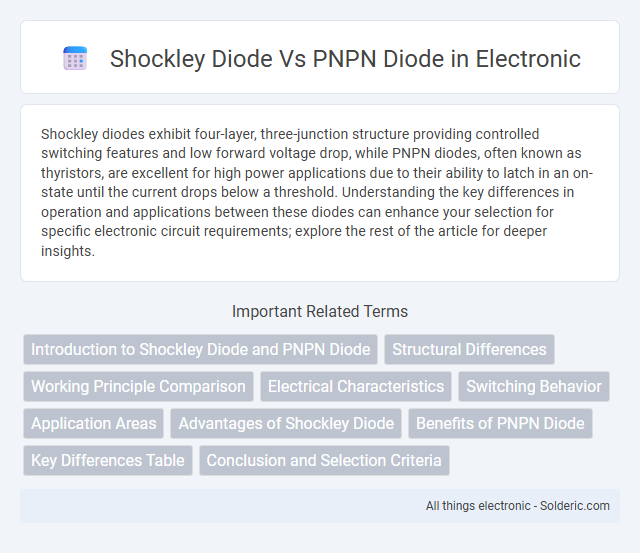Shockley diodes exhibit four-layer, three-junction structure providing controlled switching features and low forward voltage drop, while PNPN diodes, often known as thyristors, are excellent for high power applications due to their ability to latch in an on-state until the current drops below a threshold. Understanding the key differences in operation and applications between these diodes can enhance your selection for specific electronic circuit requirements; explore the rest of the article for deeper insights.
Comparison Table
| Feature | Shockley Diode | PNPN Diode (Thyristor) |
|---|---|---|
| Structure | Four-layer, two-junction (PNPN) | Four-layer, three-junction (PNPN) |
| Function | Acts as a switch, latching diode | Controlled rectifier, switching device |
| Control | No external gate; latches after breakover voltage | Has gate terminal for triggering |
| Triggering | Triggered by voltage exceeding breakover voltage | Triggered by gate current |
| Applications | Voltage-triggered switching | Phase control, motor speed control, rectifiers |
| Holding Current | Present, latches on minimal current | Present, device turns off below holding current |
| Symbol | Diode with triggering characteristic | Typical thyristor symbol with gate terminal |
Introduction to Shockley Diode and PNPN Diode
Shockley diode, a four-layer semiconductor device with alternating P and N regions, functions as a bistable switch, commonly used in triggering circuits due to its controlled switching characteristics. PNPN diode, also known as a thyristor or silicon-controlled rectifier (SCR), incorporates an additional PN junction enabling it to regulate high voltage and current in power control applications. Both diodes exploit their layered semiconductor structure for specialized control in electronic circuits, with Shockley diodes serving low-power triggering roles and PNPN diodes handling high-power switching tasks.
Structural Differences
Shockley diodes consist of a four-layer PNPN structure forming a thyristor-like device with two junctions that allow controlled switching. In contrast, PNPN diodes embody a four-layer semiconductor material with three junctions, enabling it to function as a semiconductor switch with regenerative feedback. The key structural difference lies in the number of PN junctions, influencing their switching and conduction properties in electronic circuits.
Working Principle Comparison
A Shockley diode operates as a four-layer PNPN semiconductor device that remains in a high-resistance, off state until the forward voltage exceeds its breakover voltage, causing it to switch to a low-resistance, on state without requiring a gate signal. In contrast, a PNPN diode, often referred to as a Silicon Controlled Rectifier (SCR), also consists of four layers but requires a triggering gate current to transition from the blocking state to the conducting state, enabling controlled switching. Both diodes function based on the principle of regenerative feedback in the PNPN structure, but the Shockley diode switches solely by voltage, while the PNPN diode switches by gate current activation.
Electrical Characteristics
Shockley diodes exhibit a two-layer semiconductor structure with a sharp breakover voltage and a negative resistance region, enabling fast switching and holding current characteristics. PNPN diodes, also known as thyristors, consist of four alternating layers, providing higher breakover voltages and sustained conduction once triggered, making them ideal for controlling large power loads. Your choice depends on whether a fast switching device or a controlled rectifier suitable for high-power applications is required.
Switching Behavior
Shockley diodes exhibit controlled switching behavior with a defined breakover voltage, transitioning from a high-resistance to a low-resistance state when the voltage exceeds this threshold. PNPN diodes, or thyristors, maintain conduction until the current drops below a holding level, enabling bistable switching ideal for latching applications. Your selection between the two depends on the desired switching control--precise voltage-triggered in Shockley diodes versus current-controlled latching in PNPN devices.
Application Areas
Shockley diodes are commonly used in triggering circuits, overvoltage protection, and switching applications due to their ability to switch from a high-resistance state to a low-resistance state quickly. PNPN diodes, also known as thyristors or Silicon Controlled Rectifiers (SCRs), find extensive use in power control, motor speed regulation, and phase control in AC circuits. Your choice between these diodes depends on the specific requirements of switching speed, voltage control, and power handling in industrial and electronic applications.
Advantages of Shockley Diode
Shockley diodes offer superior switching speed and lower forward voltage drop compared to PNPN diodes, enhancing efficiency in high-frequency applications. Their simpler structure results in reduced manufacturing costs and increased reliability for your electronic circuits. These advantages make Shockley diodes ideal for precise triggering and fast switching in power control systems.
Benefits of PNPN Diode
PNPN diodes, also known as thyristors, offer superior control in high-power applications due to their ability to handle large currents and voltages, making them ideal for switching and rectification purposes. Unlike Shockley diodes, PNPN diodes exhibit latching behavior, maintaining conduction after triggering until the current drops below a certain threshold, which enhances circuit efficiency and reliability. Their robust gating mechanism allows precise control, enabling use in controlled rectifiers, motor speed controls, and overvoltage protection devices.
Key Differences Table
The Shockley diode, a four-layer semiconductor device with two PN junctions, functions as a bistable switch, turning on at a specific forward voltage and remaining on until the current drops below a holding level. In contrast, the PNPN diode, commonly known as a Silicon Controlled Rectifier (SCR), features a similar four-layer structure but offers controlled switching via a gate terminal, providing precise triggering capabilities. Your choice between these diodes depends on whether you need triggering control (PNPN diode) or simple voltage-controlled switching (Shockley diode).
Conclusion and Selection Criteria
Shockley diodes excel in applications requiring precise triggering and low holding current, making them ideal for sensitive switching circuits. PNPN diodes, or thyristors, offer higher current handling and are better suited for power control and phase angle applications. Your choice depends on the need for switching speed and current capacity, with Shockley diodes favored for low-power triggers and PNPN diodes for robust power control.
Shockley diode vs PNPN diode Infographic

 solderic.com
solderic.com